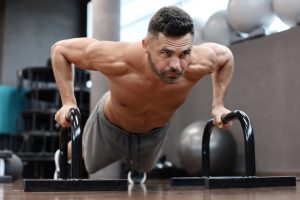Shoulder pain when lifting weights usually means you're dealing with a rotator cuff injury, shoulder impingement, or inflammation from overuse—problems that stem from poor form, training too hard too fast, or muscle imbalances around the joint.
The good news is that most shoulder pain is treatable and preventable once you understand what's happening and what to do about it, so keep reading to learn how to diagnose your specific issue, treat it effectively, and stop it from coming back.
Why Weightlifters Experience Shoulder Pain
Your shoulder can move in more directions than any other joint in your body.
This incredible range of motion lets you reach overhead, behind your back, and across your chest—movements that make exercises like overhead presses, pull-ups, and bench presses possible.
But there's a catch.
That same flexibility makes your shoulder inherently unstable.
Unlike your hip joint, which fits snugly into a deep socket, your shoulder sits in a shallow socket that prioritizes movement over security.
When you add heavy weights to this already-vulnerable structure, the risk multiplies.
The numbers tell the story.
Studies show that 18-26% of adults experience shoulder pain, and when you look specifically at weightlifters, 36% of all training injuries happen at the shoulder complex.
This isn't bad luck—it's biomechanics.
Every time you load your shoulders during a lift, you're asking an inherently mobile joint to suddenly become stable enough to handle serious weight.
Think of it as an engineering trade-off.
Your body designed your shoulders for maximum mobility, which means it sacrificed some stability to get there. In everyday life, this works perfectly.
But in the gym, where you're pressing, pulling, and lifting loads your shoulders weren't evolutionarily designed to handle, that lack of built-in stability becomes a problem.
The muscles, tendons, and ligaments surrounding your shoulder have to work overtime to compensate, and when they can't keep up—through poor form, overtraining, or muscle imbalances—something eventually gives.
The Most Common Shoulder Injuries from Lifting
When your shoulder starts hurting during or after workouts, you're likely dealing with one of six conditions.
Knowing which one helps you treat it correctly and get back to training faster.
Many of these injuries share overlapping symptoms, which is why professional evaluation often becomes necessary, but understanding the distinct characteristics of each condition gives you a head start.
Rotator Cuff Injuries
This is the injury you're most likely to face as a weightlifter.
Your rotator cuff consists of four muscles—the supraspinatus, infraspinatus, teres minor, and subscapularis—that work together to stabilize your shoulder joint during movement.
When you overtrain or use poor form repeatedly, these muscles develop inflammation that eventually leads to degeneration.
You'll know something's wrong when pain settles into your shoulder and radiates down your upper arm.
Overhead activities become difficult or impossible.
Lifting your arm forward or out to the sides takes noticeable effort, and you might see swelling around the joint.
The weakness develops gradually, getting worse over weeks or months if you don't address it.
Shoulder Impingement Syndrome
Here's a sobering statistic: up to two-thirds of all shoulder pain cases trace back to impingement.
This happens when the soft tissues between your shoulder blade and upper arm bone get compressed during overhead movements.
The crushing affects both your rotator cuff tendons and the bursa sacs that cushion your joint, creating pain and limiting how far you can move your arm.
Weightlifter's Shoulder (Distal Clavicular Osteolysis)
The name tells you exactly who gets this condition.
Repetitive stress—think heavy bench presses, dips, and overhead work—creates tiny fractures where your collarbone meets your shoulder blade at a junction called the acromion.
Over time, accumulated micro-trauma causes the bone at the end of your collarbone to break down and deteriorate.
The pain concentrates right at that meeting point and won't quit.
Biceps Tendinitis
Your biceps tendon runs through the front of your shoulder, making it vulnerable to inflammation from repetitive motion.
When it flares up, you'll feel pain in the front of your shoulder that sometimes travels down your arm.
The real danger comes during eccentric contractions with heavy weight—picture the lowering phase of a biceps curl.
That's when the tendon is most likely to rupture completely.
If it does, you'll see the telltale “Popeye sign”: a bulge in your upper arm where the muscle bunches up without the tendon holding it in place.
Subacromial Bursitis
Bursa sacs act as cushions between the moving parts of your shoulder joint.
Repetitive overhead lifting inflames these protective sacs, and once they're irritated, every overhead movement hurts.
You'll also feel pain when you press directly on the sore area—a simple test that helps identify this specific condition.
SLAP Tears
SLAP stands for Superior Labrum Anterior and Posterior, referring to damage in the cartilage rim (labrum) that lines your shoulder socket.
For weightlifters, the most common cause is straightforward: lifting too heavy before you're ready.
The symptoms are distinctive—painful clicking and popping sounds when you move your shoulder, pain during overhead movements, and difficulty rotating your shoulder inward.
If you hear your shoulder making noises it never made before, pay attention.
What's Actually Causing Your Shoulder Pain
Shoulder injuries don't appear out of nowhere.
They develop from specific, identifiable problems in how you train.
Understanding these root causes matters because fixing the underlying issue prevents the injury from returning once you've healed.
Technical Problems
Improper technique sits at the top of the list for good reason.
When your form breaks down, other parts of your body start overcompensating to complete the movement.
This redistribution of force creates injury risk that compounds with every rep.
Overhead exercises are particularly unforgiving—poor form during these movements dumps excessive stress directly onto your shoulder joint.
Take deltoid training as an example.
Shoulder presses, lateral raises, and upright rows are staples in most programs, but executing them with bad form is one of the fastest ways to injure your rotator cuff.
Your form might look acceptable to you, but small deviations—like letting your elbows drift too far forward or arching your back to cheat the weight up—accumulate damage session after session.
Training Mistakes
Your tendons adapt to stress, but they need time.
Rapidly increasing your training load, frequency, or duration without giving tendons a chance to build tolerance triggers the exact inflammatory response that leads to tendinopathy.
You might feel fine during the workout, but the damage is happening at a microscopic level.
Lifting too heavy too soon creates similar problems.
Your muscles might feel ready to handle bigger loads, but if they haven't actually adjusted through proper progression, you're setting yourself up for injury.
Add insufficient rest to this equation and you've created a perfect storm. Rest days aren't optional—they're when your body repairs the micro-damage from training.
Skip them, and injury stops being a possibility and becomes inevitable.
The Muscle Imbalance Problem
Most weightlifters train what they can see in the mirror.
You press, you fly, you raise—building your deltoids, pecs, and trapezius while the smaller rotator cuff muscles get minimal direct work.
This creates a dangerous imbalance between your global movers (the big muscles that generate force) and your local stabilizers (the small muscles that keep your joint secure).
The same pattern shows up in strength and flexibility imbalances between the muscles controlling your shoulder blade and upper arm.
When these muscle groups can't coordinate properly, your shoulder loses the stability it needs during loaded movements.
The resulting compensation patterns force certain structures to work harder than they should, leading directly to impingement and other injuries.
Posture and Mobility Limitations
Limited range of motion in your shoulder joint increases impingement risk, especially during overhead movements.
If you can't achieve full range naturally, your body finds workarounds that put stress on vulnerable tissues.
Poor posture multiplies these problems.
When your head and neck pull forward and your shoulders slump, your shoulder blades tilt forward with them.
This positioning places your deep rotator cuff muscles in a mechanically disadvantaged position where they can't function optimally.
The space under your acromion (the subacromial space) decreases, creating the perfect environment for impingement every time you lift your arm overhead.
Critical Warning Signs That Require Medical Attention
Not all shoulder pain requires a doctor's visit, but certain symptoms signal serious damage that needs professional evaluation.
Knowing the difference between “rest and monitor” and “get help now” can prevent a manageable injury from becoming a surgical case.
Get Emergency Care Immediately If You Experience:
- Arm weakness or complete inability to lift it – This suggests a full rotator cuff tear, not just inflammation
- Immediate swelling after lifting something heavy – Sudden swelling indicates acute trauma that needs assessment
- Severe shoulder pain – Intensity that stops you in your tracks could mean complete tissue rupture or severe bursitis
- Inability to move your arm away from your body – Loss of this basic function signals significant structural damage
- Visible shoulder deformity – If your shoulder looks different than it did before, something has displaced or torn
These aren't “wait and see” situations.
You need imaging and expert evaluation to determine the extent of damage and whether immediate intervention can prevent permanent dysfunction.
Schedule an Appointment Soon If You Notice:
- Pain lasting beyond a few weeks despite rest and conservative treatment – Persistent pain suggests the injury won't resolve on its own
- Consistent or worsening pain despite rest and over-the-counter pain relief – Progressive symptoms indicate ongoing damage
- Pain accompanied by redness, warmth, and swelling – This combination suggests infection or inflammatory response requiring medical management
- Pain during overhead lifting or reaching behind your back – Specific movement pain, especially with clicking or snapping sensations, points to mechanical problems that need diagnosis
- Clicking or snapping sensations during movement – Abnormal sounds often indicate labral tears or other structural issues
These symptoms won't send you to the emergency room, but they're your body telling you that something needs professional attention before it gets worse.
Evidence-Based Treatment Approaches

The moment you recognize shoulder pain from lifting, your response determines whether you're looking at a quick recovery or months of problems.
Treatment follows a clear progression, starting with immediate damage control and building toward long-term rehabilitation.
Your First 48-72 Hours
Stop all upper body lifting immediately.
Continuing to train through pain compounds the damage and extends your recovery timeline significantly.
Apply ice 2-3 times daily for 20 minutes per session to control inflammation.
Take anti-inflammatory medications like ibuprofen or naproxen to manage pain, particularly if you're dealing with tendinitis-related issues.
The RICE protocol gives you a framework: Rest means avoiding any activities that trigger shoulder pain, not just skipping the gym.
Ice reduces inflammation and numbs acute pain. Compression helps control swelling.
Elevation decreases blood flow to the area, further limiting inflammation.
These aren't complex interventions, but they work when applied consistently during the acute phase.
Physical Therapy: The Non-Negotiable Component
Here's what most people miss—rest alone won't fix the underlying problem.
You need to work with a physiotherapist who specializes in shoulder rehabilitation.
They'll focus on isometric exercises that strengthen your rotator cuff tendons without aggravating the injury.
The goal is recruiting your outer muscles to support the supraspinatus muscle, taking pressure off the damaged tissue.
Shoulder-specific strengthening and range of motion exercises provide long-lasting relief for chronic shoulder pain in ways that general treatment can't match.
Research consistently shows this targeted approach outperforms standard medical care for persistent shoulder problems.
Specific Exercises That Work for Impingement
Three exercises form the foundation of impingement recovery.
The isometric wall push involves pressing against a wall at 25-50% of your maximum pressure and holding for 10 seconds.
External rotation starts with light weights—literally a 1-pound water bottle—to rebuild strength without overloading damaged tissues.
Scapular strengthening rounds out the trio, targeting the muscles that control your shoulder blade position.
Practice these daily and you should feel improvement within about two weeks.
If six weeks pass without results or your pain worsens, you need evaluation from a physical therapist or physiatrist.
Building Long-Term Shoulder Health
Recovery programs should continue for 4-6 weeks minimum, targeting your rotator cuff muscles, deltoids, and scapular stabilizers.
Emphasize periscapular muscle strengthening—those small rotator cuff muscles that provide joint stability.
Eccentric strengthening deserves special attention because it lengthens muscles under load while minimizing stress across the joint, making it ideal for rebuilding strength in damaged tissues.
When Conservative Treatment Isn't Enough
If pain becomes too severe for rehabilitation exercises, steroid injections can provide the relief you need to start therapy.
But here's the catch—injections without follow-up rehabilitation just mask the problem temporarily.
You must commit to regular physical therapy after the injection or you're wasting the intervention.
Severe or persistent cases sometimes require surgery.
Subacromial decompression creates more space for your rotator cuff tendons and bursa, while rotator cuff repair addresses tears that won't heal on their own.
These aren't first-line treatments, but they become necessary when conservative approaches fail.
What Recovery Actually Looks Like
Set realistic expectations based on your specific injury.
Delayed onset muscle soreness (DOMS) resolves within 72 hours—if pain lasts longer, you're dealing with actual injury, not just muscle fatigue.
Weightlifter's shoulder typically needs 6-8 weeks of proper treatment for complete recovery.
Shoulder impingement should show improvement within two weeks of daily exercises, with full recovery taking longer depending on severity.
Prevention Strategies and Exercises to Modify or Avoid
Prevention beats rehabilitation every time.
The strategies below address the root causes of shoulder injuries before they develop, keeping you training consistently instead of cycling through injury and recovery.
Master Form on the Exercises That Injure Most People
Bench press technique matters more than most lifters realize. Limit 1-rep max attempts to a few times per year—the risk-reward ratio doesn't favor frequent testing.
Vary your grips between sessions to prevent overuse patterns that stress the same structures repeatedly.
Behind-the-neck shoulder presses belong in the “never do” category.
They place significant strain on your ligaments and create impingement almost by design.
Press from the front instead, keeping the bar path in front of your face where your shoulder mechanics can handle the load safely.
Lat pull-downs require specific positioning.
Pull the bar to your chest near the bottom of your sternum with your trunk reclined about 30 degrees.
Never pull behind your head—this variation increases injury risk without providing better muscle activation.
Structure Your Training for Joint Health
Add repetitions gradually when starting new programs.
Your muscles adapt faster than your connective tissue, so what feels manageable to your muscles might be overloading your tendons.
Balance push and pull exercises in a 1:1 ratio—for every pushup, do a row.
This prevents the front-to-back imbalances that create postural problems and impingement.
Work your rotator cuff and deltoid muscles together, not separately.
For every set targeting your rotator cuff, do one set targeting your deltoids.
This coordinated approach maintains the balance between stabilizers and prime movers.
Allow 1-2 days of rest after resistance training and heavy lifting.
Your muscles need this recovery window to repair and adapt without accumulating inflammatory damage.
The Warm-Up You Actually Need
Dynamic movements prepare your shoulders for loaded work better than static stretching.
Arm circles, shoulder shrugs, and resistance band exercises activate the muscles and increase blood flow to the joint.
Research shows proper warm-ups significantly reduce injury risk, yet most people skip them or rush through halfhearted versions.
Positioning and Activation Cues
Monitor your shoulder blade position before initiating any exercise. Injuries often stem from loading your shoulder when it's already in a drooped, forward-tilted posture.
Before pulldowns, activate your lower trapezius muscles by bringing your shoulders down and together.
This creates stability and positions your joint optimally for the movement.
Progressive Overload Without Injury
Start with weights that allow 2 sets of 8-10 repetitions—typically 1-2 pounds for isolation work.
Progress to 3 sets before adding weight.
When the exercise becomes easier, increase weight in 1-pound increments up to a maximum of 5-10 pounds.
When you add weight, drop back to 2 sets and rebuild volume.
This methodical approach lets your tendons adapt alongside your muscles.
High-Risk Exercises: Modify or Eliminate
Some exercises injure shoulders more often than they build them:
Upright rows compress the subacromial space during every rep. Keep your elbows below shoulder level or skip them entirely—other exercises train the same muscles with less risk.
Behind-the-neck pulldowns force your shoulders into compromised positions. Always pull to your chest instead.
Bench dips load your shoulders at extreme ranges of motion where the joint is least stable. Modify the angle to reduce strain or choose alternative triceps exercises.
Overhead presses with dumbbells become problematic in the final degrees of movement where the weights come together overhead. This position stresses your AC joint. The free movement of dumbbells makes it easy to lose control during this vulnerable phase, making them riskier than barbell variations.
Lateral raises done too heavy or with elbows rising above shoulder height jam your rotator cuff tendons against bone. Keep the weight manageable and stop when your arms reach parallel to the floor.
The pattern across all these movements is clear: exercises where your elbows repeatedly rise above your shoulders create chronic impingement that eventually breaks down tissue.
Recognize this mechanism in your own programming and adjust accordingly.
Conclusion
Shoulder pain from lifting weights stems from identifiable causes—poor technique, training errors, muscle imbalances, and mobility limitations—that you can address before they sideline your training.
The key is recognizing early warning signs, responding with appropriate treatment, and building prevention strategies into your programming from day one.
Master proper form, progress methodically, and give your shoulders the recovery and conditioning work they need, and you'll spend more time training and less time rehabilitating.







